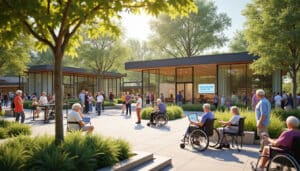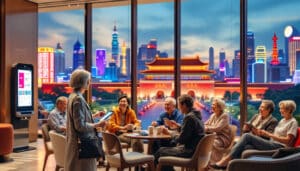“`html
Hello and welcome! Your experience is at the heart of our concerns. Let’s discover together how we improve our services.
To offer you a smooth browsing experience, we use cookies and data. These tools allow us to maintain and deliver our services efficiently while monitoring interruptions and protecting ourselves against spam, fraud, and abuse. By measuring our audience’s engagement and analyzing our site’s statistics, we better understand how you use our services and continuously work to improve their quality.
If you choose “Accept all,” we will also use cookies and data to develop and perfect new services, assess the effectiveness of advertisements, and provide you with personalized content based on your preferences. Additionally, tailored advertisements will be displayed based on your settings and previous interactions on this browser, such as your past searches on Google.
By choosing “Reject all,” we will not use cookies for these additional purposes. The non-personalized content you see is determined by the elements you are currently consulting, your activity during your active search session, and your general location. Non-personalized ads consider the content you are viewing and your geographical location.
In addition, we tailor your experience based on your age, if necessary. For more details, select “More options” to manage your privacy settings and control your preferences.

Overview of Episode 12 on China
Dive into episode 12 dedicated to China, a thorough exploration of the current dynamics shaping this Asian giant. This episode offers a panoramic view of the economic, social, and technological changes influencing not only China but also the rest of the world. As the editor-in-chief, I am delighted to guide you through the main themes discussed, the innovations presented, and the global impact of this episode on our understanding of modern China.
What are the main themes discussed in episode 12?
Episode 12 focuses primarily on the silver economy in China, a rapidly growing sector due to the aging population. With over 250 million elderly people, China is looking towards innovative solutions to meet the growing needs of this age group. Among the highlighted topics is the rise of luxury trains dedicated to seniors, an initiative aimed at providing comfortable and secure travel for retirees. To learn more, check out this detailed article on luxury trains in China.
Another central theme is economic monitoring and market assistance devices designed for the well-being of elderly individuals. These technologies, often compared to cyborgs, allow for monitoring and improving the quality of life of seniors while maintaining their autonomy. This innovative approach is essential to manage an aging population and is discussed in depth in the episode.
Finally, the episode addresses the integration of high-tech robots in elderly care, a trend that is revolutionizing the healthcare sector in China. These robots provide daily support, ranging from assistance with mobility to social companionship, representing the future of personalized care.
How does episode 12 explore modern Chinese culture?
Episode 12 offers a unique perspective on modern Chinese culture, highlighting the interaction between ancestral traditions and technological innovations. China, while preserving its millennia-old customs, adopts cutting-edge technologies to improve the daily lives of its elderly citizens. This duality is at the heart of the discussions, illustrating how Chinese society adapts to the challenges of the 21st century.
A fascinating aspect addressed is how lifestyles change with increasing longevity. Chinese seniors are no longer content to reduce their activities but invest in leisure and travel, particularly through silver tourist trains. These trains are not just a means of transport but also a social space where retirees can share enriching experiences. For an in-depth analysis, read this article on the initiative for luxury trains for seniors in China.
Moreover, the episode explores the role of media and digital platforms in the daily lives of elderly individuals. The increased use of digital technologies allows seniors to stay connected, informed, and engaged in society, contributing to a better quality of life.
What technological innovations are presented in the episode?
Episode 12 highlights several technological innovations that are transforming the landscape of elderly services in China. Among these technologies, high-tech robots play a central role by offering daily assistance to seniors. These robots, equipped with advanced sensors and artificial intelligence, can monitor users’ health, provide medication reminders, and even offer companionship, thereby reducing the loneliness often felt by older individuals.
Another key innovation presented is the development of market assistance devices, similar to cyborgs, that enable continuous economic and social monitoring. These devices collect real-time data on the physical condition and health status of seniors, allowing for rapid intervention when needed. This technology is essential to ensure the safety and well-being of elderly individuals while providing them with greater autonomy.
The episode also discusses the luxury trains dedicated to seniors, a revolutionary initiative that combines comfort, safety, and onboard health services. These trains offer a travel experience tailored to the specific needs of retirees, including relaxation spaces, medical services, and social activities. For more details, check the article on luxury trains for seniors in China.
Finally, the episode explores the integration of economic monitoring technologies in elderly services, facilitating proactive management of needs and available resources.
What impact does episode 12 have on the perception of China?
Episode 12 plays a crucial role in shaping the perception of China on a global scale, highlighting its advancements in the field of the silver economy and care technologies. By presenting innovative solutions to address the challenges of an aging population, the episode demonstrates China’s dynamism and adaptability in the face of social and economic issues.
One of the significant impacts is the emphasis on the social responsibility assumed by China to improve the quality of life of its seniors. Initiatives such as silver tourism trains and care robots highlight a deep commitment to the well-being of the elderly population, thus strengthening the image of a progressive and humane country.
Additionally, by exploring concepts like economic monitoring, the episode prompts reflections on the balance between technological innovation and respect for privacy. This opens an important debate on ethical boundaries and best practices to ensure that technologies genuinely serve the well-being of individuals without compromising their personal freedom.
Furthermore, the episode contributes to a better understanding of the challenges China faces in the global context, particularly concerning human resource management and sustainable development. In doing so, it reinforces China’s position as a major global player, capable of responding effectively to the needs of a constantly evolving society.
Where to watch episode 12 and how to engage further?
For those who wish to watch episode 12 and explore in depth the themes discussed, it is available on major streaming platforms. You can access the episode via platform name, where it is broadcast in high definition with subtitles available in multiple languages for better accessibility.
In addition to watching, it is encouraged to engage further with the content by participating in online discussions and sharing your impressions on social media. Joining forums and dedicated groups allows you to meet other enthusiasts and exchange enriching viewpoints on the subjects discussed.
Moreover, for those who want to deepen their knowledge of the themes presented in the episode, it is recommended to read specialized articles such as the impact of high-tech robots in elderly care in China or Singapore’s investments in China’s silver economy. These readings offer complementary and in-depth perspectives on the topics covered.
Finally, to stay informed of the latest developments and future episodes, subscribe to the site’s newsletter or follow the official accounts on social media. This will ensure you don’t miss any updates and actively participate in the community of China enthusiasts.
The future prospects of the silver economy in China
In conclusion of this episode, the future prospects of the silver economy in China are particularly promising. With a growing aging population, the demand for specialized services will continue to rise, thus offering numerous opportunities for innovation and investment. The initiatives presented, such as luxury trains for seniors and care robots, are just the tip of the iceberg.
The strategies implemented today to meet the needs of the elderly will lay the foundations for a future where the well-being and quality of life of seniors will be at the heart of national priorities. Collaboration between the public and private sectors, along with the rapid adoption of new technologies, will be crucial for the success of these initiatives.
Thus, episode 12 not only describes the current state of affairs but also offers an inspiring vision of what China could be in the coming years. By highlighting innovative solutions and emphasizing the importance of adaptation to demographic challenges, this episode demonstrates the immense potential of the silver economy in China and its crucial role in the country’s socio-economic development.
The challenges to be addressed for a sustainable silver economy
Despite positive prospects, several challenges remain to ensure the sustainability of the silver economy in China. One of the main obstacles is the need for suitable infrastructure and effective public policies to support ongoing initiatives. The transition to a senior-centered economic model requires significant investments in healthcare, transportation, and information technology infrastructure.
Another major challenge is the training and adaptation of the workforce. Healthcare and elderly care professionals must be trained to use new technologies and provide quality care tailored to the specific needs of seniors. This also involves rethinking training and professional development models to integrate the necessary technological and interpersonal skills.
Furthermore, it is essential to ensure social inclusion and combat the isolation of elderly individuals. While technologies like care robots can greatly improve quality of life, they must not replace the critical human interactions necessary for the emotional well-being of seniors. It is therefore important to find a balance between automation and maintaining traditional social ties.
Finally, the issue of environmental sustainability must also be taken into account. Initiatives aimed at supporting the silver economy must be designed to minimize their ecological impact, integrating environmentally friendly practices into all aspects of their implementation.
By proactively addressing these challenges, China can not only strengthen its silver economy but also provide an inspiring model for other countries facing similar issues related to the aging of their population.
International initiatives related to the Chinese silver economy
Episode 12 does not limit itself to an internal analysis of China but also explores international initiatives that interact with the country’s silver economy. One of the most notable examples is the collaboration with foreign companies such as Perennial from Singapore, which are investing heavily in China’s elderly services sector. This cross-border cooperation allows for an exchange of knowledge and technology, thus fostering mutual and sustainable growth.
Additionally, partnerships with universities and international research institutes contribute to innovation in elderly care. These collaborations enable the development of innovative solutions tailored to the specifics of the Chinese market while benefiting from global scientific advancements and expertise.
Moreover, the episode addresses the market strategies adopted by international companies to integrate into the Chinese silver economy. These strategies include adapting products and services to local needs, creating joint ventures with Chinese companies, and participating in government initiatives aimed at improving care infrastructure for seniors.
These international initiatives play a crucial role in invigorating the silver economy in China, bringing new perspectives and enhancing the country’s innovation capacities. They also illustrate the importance of global cooperation in addressing challenges related to population aging, a universal issue that requires collective and coordinated solutions.
By exploring these international dynamics, episode 12 offers an in-depth understanding of the mechanisms of the Chinese silver economy and its integration into a constantly evolving global economy.
The social implications of the silver economy in China
Beyond economic and technological aspects, episode 12 examines the social implications of the silver economy in China. The aging population profoundly affects the social structure, influencing family dynamics, resource distribution, and social policies. In response, China is adopting measures to strengthen support for seniors, emphasizing social inclusion and active participation of elderly individuals in the community.
One of the major implications is the evolution of traditional family roles. As family structures change, with an increasing number of single-parent families and families residing away from their elderly relatives in urban areas, it becomes crucial to develop robust community support systems. The episode discusses how initiatives such as luxury trains for seniors facilitate family reunions and provide socializing spaces for the elderly.
Furthermore, the episode explores the importance of promoting a culture of respect and valuing seniors, integrating educational programs and awareness campaigns to combat stigma and prejudices related to aging. These efforts aim to create a more inclusive society where elderly individuals are recognized for their contributions and wisdom.
Finally, the focus is on the autonomy and dignity of seniors, providing them with the means to live independently while benefiting from appropriate supports. Care technologies, such as high-tech robots, play a key role in this approach, enabling seniors to maintain their independence while accessing quality care and services tailored to their specific needs.
By addressing these social implications, episode 12 offers a holistic view of the silver economy, highlighting the importance of creating a favorable and supportive societal environment for seniors, thereby ensuring a better quality of life and a harmonious integration within the community.
The impact of government policies on the silver economy
A central element of episode 12 is the analysis of the impact of government policies on the development of the silver economy in China. The Chinese government has implemented a series of reforms and programs aimed at supporting the growing needs of the elderly, recognizing the crucial role of this population segment in society and the national economy.
Key initiatives include subsidies for companies developing care technologies, such as high-tech robots, as well as tax incentives for health services dedicated to seniors. These policies foster innovation and attract investments in a booming sector, thus stimulating economic growth and the creation of specialized jobs.
Additionally, the government has established professional training programs for elderly care professionals, ensuring a high quality of service and ongoing adaptation to new technologies. These programs also aim to attract more young people to the sector by highlighting careers related to the care and support of seniors.
Housing and transportation policies also play a crucial role in the silver economy. Initiatives like luxury trains for seniors are supported by subsidies and public-private partnerships, facilitating elderly individuals’ access to comfortable and secure transportation services. This not only enhances seniors’ mobility but also contributes to their overall well-being.
Finally, episode 12 examines how public health policies are adapted to respond to the specific needs of seniors, including prevention programs, long-term care, and rehabilitation services. These policies are essential to ensure comprehensive and integrated care for elderly individuals, thus securing their health and quality of life in the long term.
By analyzing these policies, the episode highlights the importance of government engagement in shaping and supporting the silver economy, illustrating how targeted actions can have a significant impact on the lives of elderly individuals and on society as a whole.











